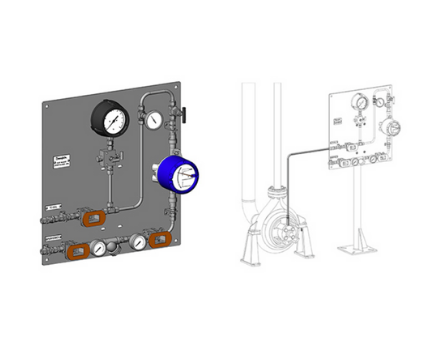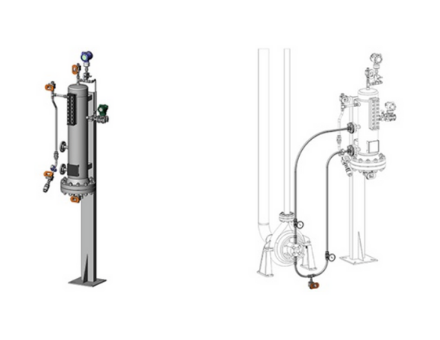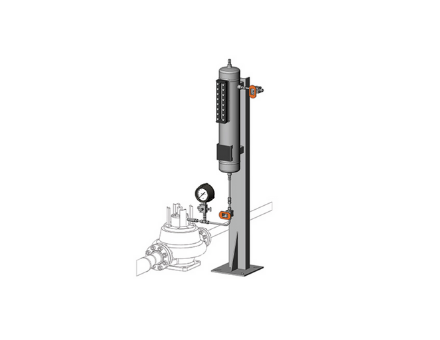Mechanical seals are designed to prevent leakage of fluid from centrifugal pumps that support industrial processes. Mechanical seals depend on mechanical seal support systems for reliable operations. I’ve provided information below to help explain mechanical seal support basics. I’m hopeful it’ll help you gain a better understanding of mechanical seals and the various types of mechanical seal support systems, their applications, and optional configurations to help boost reliability in your Northern California Bay Area refinery.
A mechanical seal is used to contain fluid within a centrifugal pump where the impeller shaft passes through a stationary housing. There’s a range of mechanical seal designs to cover every conceivable pumping process. Low to high pressure, low to high fluid temperatures, clean plant water to heavy hydrocarbons. To cover that wide range of pumping processes and conditions there’s an equally wide range of seal support systems and custom configurations to match the need.
Mechanical Seal Support Basics: Lubrication, Temperature, Pressure, and Flow
At its simplest, a mechanical seal support system is designed to provide the proper seal chamber environment to maintain the integrity of the mechanical seal. The system provides cooling and lubrication to reduce mechanical seal friction and heat and prevent leakage. To accomplish this, mechanical seal support systems deliver process fluid, water, oil, or inert gas to the seal chamber at the required pressure, temperature, and flow.
Maintaining the proper seal chamber environment prevents leakage that could lead to loss of profitable products, degradation of pumps and their supporting infrastructure, or in the worst cases, conditions that pose environmental risk and subject you to Cal/OSHA and BAAQMD sanctions.
Distilling API Standard 682 Into a Simplified Overview
Centrifugal pumps and mechanical seal support systems are critical to the petroleum industry. As a result, the American Petroleum Institute has developed a standard to describe the different seal support systems, known as piping plans. See API Standard 682: Pumps—Shaft Sealing Systems for Centrifugal and Rotary Pumps for a listing of the various plans. The complete document is over 250 pages, but below I've distilled the document into a greatly simplified overview of mechanical seal support basics.
Mechanical seal support systems can be grouped into three categories—process side, dual or in-between, and atmospheric side. Let me explain the basics of these categories by describing the type of mechanical seal, the typical pumping applications, and the various API plans that provide the required environment for the mechanical seal and pumping conditions.
Process Side Mechanical Seal Support Basics
Process side mechanical seal support systems provide the lubrication and cooling to a single mechanical seal to keep process fluid within the pump volute. Process fluid is used for lubrication and cooling in three ways: it is circulated from the discharge to seal chamber, from the seal chamber to the suction, or from discharge to seal chamber and then to suction. Alternatively, a flush fluid that provides lubrication and cooling can be delivered from a reservoir which is part of the seal support system or an external source, such as plant water.
This single-seal solution is used when the pumped fluid poses no environmental threat in the event that the pumped fluid vaporizes as it crosses the seal faces and dissipates into the atmosphere. The table below summarizes the API Plans in the process side category, indicates the types of fluids used to provide cooling and lubrication, and the components that differentiate the plans and their capabilities.
| |
API Plans
|
| |
11
|
12
|
13
|
14
|
21
|
22
|
23
|
31
|
32
|
41
|
|
Process fluid (from pump)
|
⚫
|
⚫
|
⚫
|
⚫
|
⚫
|
⚫
|
|
⚫
|
|
⚫
|
|
Flush fluid (water/glycol, oil from reservoir)
|
|
|
|
|
|
|
⚫
|
|
|
|
|
External fluid source (from plant; must be compatible with process fluid)
|
|
|
|
|
|
|
|
|
⚫
|
|
|
Pumping ring (circulates flush fluid)
|
|
|
|
|
|
|
⚫
|
|
|
|
|
Throat bushing (isolates flush fluid from process fluid)
|
|
|
|
|
|
|
⚫
|
|
⚫
|
|
|
Cooler (maintain process or flush fluid temperature)
|
|
|
|
|
⚫
|
⚫
|
⚫
|
|
|
⚫
|
|
Strainer/Filter (dirty process fluid)
|
|
⚫
|
|
|
|
⚫
|
|
|
|
|
|
Cyclone separator (dirty process fluid)
|
|
|
|
|
|
|
|
⚫
|
|
⚫
|
Process side mechanical seal support systems cover a range of pumping processes, from clean, moderate-temperature, non-polymerizing fluids to high-temperature dirty or contaminated fluids. Cooling and filtering options enable these plans to remove contaminants that would damage seal faces. Pumping applications can include:
- Hot water
- Slightly dirty or contaminated fluids
- Fluids with suspended solids
- Light hydrocarbon services
- High-temperature applications with slightly dirty liquid
- Process fluid with poor lubrication properties
Dual or In-Between Mechanical Seal Support Basics
Dual or in-between mechanical seal support systems deliver a buffer (unpressurized) or barrier (pressurized) fluid to a seal chamber that contains a double mechanical seal—two seals arranged in series to maintain the buffer/barrier fluid between the two seals. The inboard (primary seal) keeps process fluid within the pump housing. The outboard (secondary seal) prevents the buffer/barrier fluid from leaking to the atmosphere. The buffer/barrier fluids that lubricate the seal faces and dissipate heat can be gas or liquid.
| |
API Plans
|
| |
52
|
53A
|
53B
|
53C
|
54
|
55
|
72
|
74
|
|
Buffer fluid (unpressurized)
|
⚫
|
|
|
|
|
⚫
|
⚫
|
|
|
Barrier fluid (pressurized)
|
|
⚫
|
⚫
|
⚫
|
⚫
|
|
|
⚫
|
|
Buffer/barrier fluid must be compatible with process fluid
|
⚫
|
⚫
|
⚫
|
⚫
|
⚫
|
|
|
⚫
|
|
Fluid reservoir
|
⚫
|
⚫
|
⚫
|
⚫
|
|
|
|
|
|
Vent to collection system
|
⚫
|
|
|
|
|
|
⚫
|
|
|
Pumping ring (circulate barrier fluid)
|
|
⚫
|
⚫
|
⚫
|
|
|
|
|
|
Heat exchanger (cool buffer/barrier fluid)
|
|
|
⚫
|
⚫
|
⚫
|
⚫
|
|
|
|
External fluid reservoir and pump
|
|
|
|
|
⚫
|
⚫
|
|
|
Pressurization of barrier fluid is provided by plant nitrogen, bladder accumulator, piston accumulator for API Plans 53A, 53B, and 53C respectively. Plan 54 is pressurized by the external pump. Plan 72 buffer fluid is plant nitrogen.
Dual mechanical seals and seal support systems provide the best protection against pump leakage when:
- Process fluid or vapors would pose hazardous, toxic, flammable risks to personnel and/or the environment
- High pressure and high-temperature processes are involved
- Process fluids are polymerized
- Dirty, abrasive process fluids that damage seal faces are present
Atmospheric Side Mechanical Seal Support Basics
Atmospheric side mechanical seal support systems deliver an unpressurized fluid (also known as a “quench”) to the atmospheric side (exposed to air) of a mechanical seal. This method is used when a single mechanical seal cannot operate properly without the aid of the quench. In comparison to the process side and dual seal support systems, there are only two variants:
API Plan 51 - Quench From Reservoir is typically used on vertical pumps to prevent “icing” on the atmospheric side of the seal.
API Plan 62 - Quench From External Source delivers clean water, low-pressure steam, or nitrogen to cool the seal faces and prevent oxidation or coking of process fluid.
Swagelok: Mechanical Seal Support Basics & Industry Experience for Optimized Solutions
Our brief explanation of mechanical seal support system basics shows you the wide range of capabilities and applications. There’s a solution for every type of pumping process. You don’t need an in-depth understanding to obtain the maximum benefit from a mechanical seal support system if you work with a local vendor in the Northern California Bay Area who has deep industry experience.
In addition to knowing which mechanical seal support system is best for a specific pumping process, a local vendor who conducts an on-site evaluation is able to make specific recommendations regarding system design, instrumentation, and components to boost pump reliability. Fabricated and thoroughly tested in Swagelok’s Fremont, Santa Clara, or Concord facility, you’ll have a mechanical seal support solution custom-configured to the specific requirements of your pumping process.
Swagelok Northern California will be happy to explain mechanical seal support basics and advise you on the specific plans to improve pump reliability. To arrange an on-site consultation by one of our Field Engineers contact our team today by calling 510-933-6200.


.png?width=600&name=image1%20(8).png)



